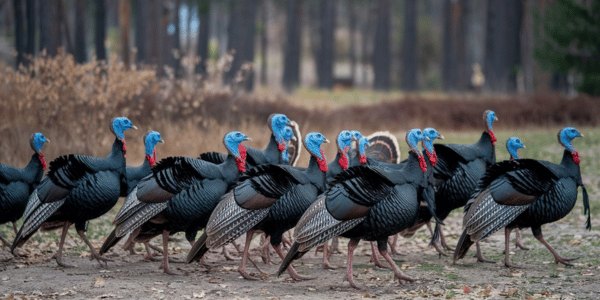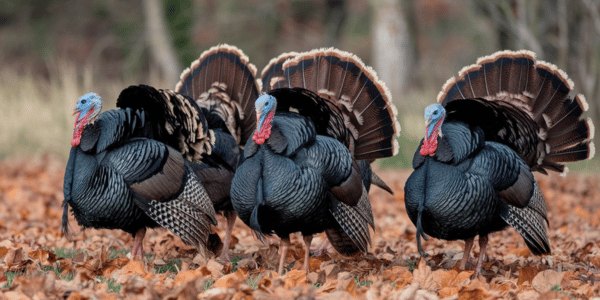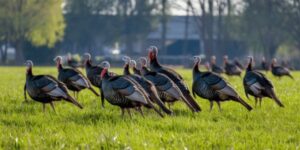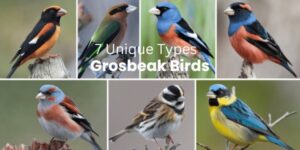Few birds are distinctive in their appearance and intriguing behaviors as the Wild Turkey one can find across North America. It doesn’t matter if you are a passionate ornithologist or want to know some facts about these birds; it is always beneficial to know what these lovely birds are called. As it is of wild turkeys, the most common questions asked is: What is a group of wild turkeys called? This article will detail not only the correct terminology but also the background, behavior, and relation of these birds to the cultures of the people.
The Proper Term
A group of wild turkeys is called a “rafter.” This word may not be trendy since it does not so regularly come out in phrases like a ‘murder of crows’ or a pride of lions’ but has always been used to cluster turkeys. The term ‘rafter’ can paint a picture of the upper cross beams of structures, but its history is difficult to understand since its usage has become entrenched in the language of wildlife. Other names included alongside ‘rafter’ are a pack of turkeys and a flock used today.
You May Also Like: Top 10 Birds with Long Legs
Behavioral Insights
Being a social species, the wild turkey’s behaviors are predictable and often guided by safety, food, and reproduction needs. The reasons for the gathering of wild turkeys into rafters or a flock can be explained by several common reasons:
Safety in Numbers: As is true for all other birds, wild turkeys also risk predation in the presence of coyotes and bushy creatures like foxes and raptors within coarse habitats. When more eyes watch for predators, seeing and avoiding them is more accessible. This behavior is primarily expected during the cold period of the year, whereby they are forced to spread due to scarcity of food sources, and effective foraging techniques are needed.
Foraging efficiency: Feeding is further complicated because turkeys are omnivorous animals and spend most of their time searching for food. A rafter of turkeys will outspan much more space in searching for seeds, bugs, or tiny reptiles. Their cooperative feeding behavior increases the foraging success of any foragers in the flock.
Mating and Reproduction: Mating behavior mainly concerns male turkeys, called ‘toms,’ during the breeding period when they undress their plumes in leks and court hens. The meetings usually comprise two or more males and several females forming a temporary rafter but disappearing after mating.
You May Also Like: The Ultimate Guide to Blue-and-Gold Macaws

Historical and Cultural Significance of Wild Turkeys
Wild turkeys are among the animals that have played essential roles in the history and culture of North America. Native American tribes considered turkeys a source of bounty and fertility. Thus, the bird either had a place in various histories or was used in costumes for ceremonies.
The importance of the wild turkey is also well reflected in the country’s deep-rooted history, the United States of America. History shows that Benjamin Franklin was in love with the turkey nest and even suggested that it be made the national bird of the young state. The fact that a bald eagle was eventually picked has not diminished the importance of this bird in American history, as exemplified by Franklin’s admiration for turkeys.
In Which Countries Are Wild Turkeys Located?
Wild turkeys are endemic to North America and inhabit various environments, from deserts and grasslands to forests and wetlands. This bird species can adapt well to changing situations and threats to its food and shelter.
Eastern Wild Turkey (Meleagris gallopavo silvestris): The subspecies is more widely distributed and resides in the eastern U. S. and parts of Canada. Hardwoods are the most popular places, although they have also moved to mixed forests and grassland fields.
Osceola Turkey (Meleagris gallopavo osceola): The Osceola turkey is rarer than in Florida. It is smaller and darker than the other members of the subfamily and inhabits the state’s pine flatwoods and swamp regions.
Rio Grande Turkey (Meleagris gallopavo intermedia): This lowland type lives in the middle of North America’s land mass, particularly in Texas and other adjacent areas. They occupy plains or moderate contact with a few trees and shrubs.
Merriam’s Turkey (Meleagris gallopavo merriami): Commonly known as Merriam’s Turkey, these birds are common in the more elevated regions of the western part of the United States and the state of Colorado.
Mexican Turkey (Meleagris gallopavo mexicana): This rarer turkey variety inhabits parts of Arizona, New Mexico, and Mexico. It is mostly found in hilly terrains covered in oaks and pines.
You May Also Like: The 21 Ugliest Birds: Nature’s Strange Creations
Turkey Communication: Understanding Their Calls and Vocalizations
Besides their social lives, wild turkeys sing a lot, which is done for various purposes, including mating and warding off enemies. They are well-known about entire call types and qualify for the calling to locate strapped turkeys.
Gobble: Without any doubt, the most externally recognizable vocalization produced by turkeys in their raucous errant is a classic gobble. Male turkeys produce this sound during mating season to attract females and dominate other males. The call is of great resonance and can be heard by rafters even miles away, thus aiding in hunting down turkeys.
Cluck: A series of short, staccato notes used by turkeys to communicate with each other, mainly when foraging. The cluck can also signal contentment and comfort within the group.
Purr: This voluntary rolled-out tone is pronounced by a turkey, which is not vigorous and easy to use. They are usually practiced during feeding and preening times by turkeys.
Yelp: A sound common to both sexes primarily utilized when people want to communicate over relatively greater distances. It can also act as a horn after many rafters have been scattered apart.
Put: An expression that does not last long and cuts like a loud, short, sharp noise. When a turkey feels threatened, a series of puts may be sounded by it to communicate with other members.
Wild Turkey Conservation: A Success Story
Due to records of numerous successful re-introductions into the wild, especially in North America, the wild turkey is regarded as one of the most significant accomplishments in conservation efforts. However, at the beginning of the 20th century, wild turkeys faced a looming extinction threat resulting from excessive hunting and destruction of their habitats. Fortunately, this has changed in recent times owing to deliberate actions aimed at their conservation, such as hunting regulations and habitat restoration.
Wild turkeys in North America are plentiful today, and hunting seasons are regulated to ensure sustainable populations. The withdrawal is worth the problems that may delay it. Other efforts include the preservation, enlargement, and public education about turkey conservation by the National Wild Turkey Federation (NWTF).
You May Also Like: How to Keep Squirrels Out of Bird Feeders

Conclusion: The Importance of Recognizing and Protecting Wild Turkeys
It is understood that learning about the names and habits of wild turkeys, what a group of them is, and other such details is not just to satisfy one’s curiosity but is part of what it takes to fit into the wilderness. Wild turkeys, with their distinct habits and history, testify of wildlife’s magnificence when given a chance.
As we adapt to living with these beautiful birds, we also have to ensure that they do not become endangered and that we continue to have them in our sights for years to come. You can encounter a rafter of turkeys while on a quiet morning walk or listen to their warming gobbles in the woods. No matter how you meet these birds, please appreciate this remarkable species and the culture it stands for.
FAQs About Wild Turkeys
What is a group of wild turkeys called?
A group of wild turkeys is called a “rafter.” This term applies to turkeys and is used when they are gathered together. Another common term, ” flock, ” is much broader and can be used for other birds.
Why do wild turkeys gather in groups?
Wild turkeys gather in clumps or rafters for safety, improved foraging success, and breeding. They sight potential prey more quickly when they are in the company of others, spread throughout the designated area when food is obtained, and get involved in rut activities with one another during the breeding season.
Where can wild turkeys be found?
Wild turkeys are originally American and can be found in North America’s woods, forests, grassy places, and marshes. They are incredibly versatile and can be located from eastern USA to Mexico.
What are the different subspecies of wild turkeys?
According to authoritative literature, five wild turkey subspecies are found:
• Eastern Wild Turkey: Also known as Meleagris gallopavo silvestris, this species is distributed throughout the eastern United States and some regions of Canada.
• Osceola Turkey: Meleagris gallopavo osceola is present only in Florida.
• Rio Grande, Turkey: Also known as Meleagris gallopavo intermedia, this species is found in the central part of the United States, with a concentration in Texas.
• Merriam’s Turkey: It is familiar to Meleagris gallopavo merriami, which ranges in the mountains of the western United States.
• Gould’s Turkey: Also known as Meleagris gallopavo mexicana, it is found in Arizona, New Mexico, and parts of Mexico.
How do wild turkeys communicate?
Wild turkeys have different sounds that serve various purposes, such as:
• Gobble Females use a single vocal call to attract the male’s reproductive stage.
• Cluck a few short notes raised while the turkeys are feeding.
• Purr Makes about soft limitations when the turkey is contented.
• Yelp Frequently used to get the attention of other turkeys over several distances.
• Put producing sharply when a state of alarm has been brought forth.
Are wild turkeys endangered?
No, wild turkeys are not becoming extinct; instead, they are termed a successful conservation case. A large part of their population was once affected by population decline, but it has multiplied because of the successful conservation achieved.
Can wild turkeys fly?
Yes, wild turkeys can fly, and for that, they are better known for their running speeds than so. Generally, turkeys don’t fly for long distances, so they sprint to avoid an attack from some predator or settle at a branch for the night.
What do wild turkeys eat?
Wild turkeys are omnivores, so some of them feed on omitted material. Examples are seeds, nuts, berries, and some small insects or even small reptiles. What they eat also changes seasonally or according to food availability.
How long do wild turkeys live?
In the wild corrections, on average, a wild turkey may live up to 3 – 5 years. Some may survive for more extended periods. Their lifespan can be disrupted by predation diseases and many factors in the environment as well.
What is the difference between wild turkeys and domestic turkeys?
Unlike domestic turkeys, which have been selectively bred for their size and are usually fat and incapable of flying wild turkeys are, by contrast, slim and agile and can fly. Domestic turkeys mainly come from farms for meat consumption, while previous species occupied and thrived in the wild domain.











